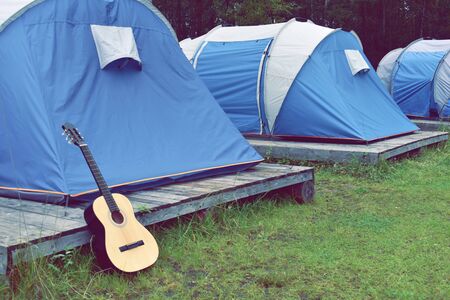1. Understanding Solar Power Basics
Before diving into setting up a solar lighting system for your off-grid campsite, its important to understand how solar power works and what components youll need. A basic solar lighting system is made up of four main parts: solar panels, a charge controller, batteries, and LED lights. Each plays a key role in collecting, storing, and using solar energy efficiently.
Solar Panels
Solar panels are the heart of any solar setup. They capture sunlight and convert it into electricity. For campsites, portable or foldable solar panels are popular because they’re lightweight and easy to set up. The size and wattage of your panel will determine how much power you can generate during the day.
Charge Controller
The charge controller sits between your solar panel and battery. Its job is to regulate the voltage and current coming from the panel so that the battery doesn’t overcharge or discharge too quickly. This helps protect your battery and extend its life.
Batteries
Batteries store the electricity generated by your solar panels so you can use it when the sun goes down. For camping setups, deep-cycle batteries like AGM or lithium-ion are often used because they’re designed for long-lasting energy storage and frequent charging cycles.
LED Lights
LED lights are ideal for off-grid systems because they use very little power while providing bright light. You can find waterproof LED strips, lanterns, or hanging bulbs that work great for different areas around your campsite—like inside tents, under awnings, or along pathways.
How These Components Work Together
Your solar panel collects sunlight and sends electricity through the charge controller to safely charge your battery. Once charged, your battery powers your LED lights whenever you need them—day or night. It’s a simple but smart system that gives you reliable lighting without needing access to the grid.
Quick Reference Table: Core Components of a Solar Lighting System
| Component | Function | Recommended Type for Camping |
|---|---|---|
| Solar Panel | Converts sunlight into electricity | Portable/Foldable 100W–200W panels |
| Charge Controller | Regulates voltage from panel to battery | PWM or MPPT (MPPT is more efficient) |
| Battery | Stores energy for nighttime use | Lithium-ion or AGM deep-cycle batteries |
| LED Lights | Provides energy-efficient lighting | 12V waterproof LED strips or lanterns |
Understanding these basics is the first step toward creating a reliable off-grid lighting setup that keeps your campsite safe and well-lit no matter where your adventures take you.
2. Choosing the Right Solar Gear for Camping Needs
When youre setting up a solar lighting system for an off-grid campsite, choosing the right gear is key to making sure you have reliable light when you need it. The best setup depends on your specific camping style, how long you stay out, how much sunlight your location gets, and how much lighting you really need. Lets break it down so you can pick the right solar panels, batteries, and lights without overcomplicating things.
Solar Panels: Matching Power to Sunlight and Usage
Solar panels come in different wattages and sizes. The right one for your setup depends on how many hours of sunlight you typically get and how much power your lights (and possibly other small devices) will use each day. Here’s a quick reference:
| Campsite Size | Sun Exposure | Suggested Panel Wattage |
|---|---|---|
| Small (1–2 people) | Full sun (6+ hrs) | 40W – 60W |
| Medium (3–4 people) | Partial sun (4–6 hrs) | 80W – 120W |
| Large group or longer stays | Limited sun (<4 hrs) | 150W – 200W+ |
Batteries: Storing Power for Nighttime Use
You’ll need a battery to store the energy your solar panel collects during the day. Battery choice depends on how much power you plan to use after dark and how many cloudy days you expect. Heres a guide based on typical needs:
| Battery Type | Best For | Pros | Cons |
|---|---|---|---|
| Lithium-ion (LiFePO4) | Frequent campers & longer trips | Lightweight, long lifespan, deep discharge allowed | More expensive upfront |
| AGM (Absorbent Glass Mat) | Weekend campers & moderate use | No maintenance, lower cost than lithium | Heavier, shorter lifespan, less efficient |
| Lead-acid (flooded) | Semi-permanent campsites with shade protection | Lowest cost option | Requires maintenance, heavy, shorter life cycle |
Lighting Options: Efficiency Over Brightness
The goal isn’t to flood your whole campsite with light—it’s to provide just enough brightness where you need it. LEDs are the way to go because they use very little power and last a long time. Here are some common types of camping lights:
Types of Camping Lights and Their Uses:
- String Lights: Great for ambient lighting around tents or eating areas.
- Lamp-style Lanterns: Ideal for table use or inside large tents.
- Motion Sensor Lights: Perfect for paths or entryways—only turn on when needed.
- Headlamps/Flashlights: Personal lighting that doesn’t drain your main system.
Sizing Your System Based on Trip Duration
The length of your camping trip also affects your setup. If youre only out for a weekend, you might get away with a small portable panel and battery pack. But if youre staying off-grid for several days or more, youll want something more robust that can recharge fully each day while powering your lights at night.
| Trip Duration | Solar Gear Recommendation |
|---|---|
| 1–2 nights (short trips) | Tiny 20–40W foldable solar panel + small lithium battery pack (100Wh) |
| 3–5 nights (medium trips) | Larger 60–120W panel + mid-size battery station (300–500Wh) |
| A week or more / full-time use | Permanently mounted 150W+ panel + high-capacity LiFePO4 battery bank (1000Wh+) |
The Key Is Balance and Portability
Your solar lighting system should be tailored to your specific needs—not too big, not too small. Think about what kind of lights youll actually use, how much sun exposure youll get during the day, and how often youll be camping off-grid. A well-balanced system saves weight in your gear and ensures youre never left in the dark after sunset.
The next step is putting it all together into a working system—stay tuned for the setup tips coming in Part 3.
![]()
3. Setting Up Your Off-Grid Power Station
If youre ready to light up your off-grid campsite with solar power, its time to assemble your system step by step. This part focuses on safely wiring your components, mounting everything securely, and making sure the setup can handle rugged outdoor conditions.
Step 1: Position Your Solar Panels
Start by choosing a sunny location with maximum exposure—ideally south-facing if youre in the U.S. Use adjustable mounts or brackets for seasonal angle adjustments. Secure the panels firmly to avoid movement during wind or storms.
Mounting Tips:
- Use stainless steel screws and rust-proof brackets
- Set tilt angle between 30°-45° depending on your latitude
- Keep panels at least 6 inches above ground to avoid debris
Step 2: Install the Charge Controller
The charge controller protects your battery from overcharging. Mount it close to the battery inside a weatherproof box or under a covered area. Connect the solar panel wires to the charge controller using labeled terminals (usually marked as “PV” or “Solar In”).
Wiring Safety:
- Always use MC4 connectors for secure connections
- Use wire rated for outdoor use (UV-resistant and waterproof)
- Install inline fuses on both positive leads—between panel/controller and controller/battery
Step 3: Connect Your Deep Cycle Battery
Your battery stores the energy collected during the day. Use thick gauge cables (like 10 AWG or thicker) for minimal voltage drop. Connect battery terminals to the charge controllers “Battery” port—positive to positive, negative to negative.
Battery Placement:
- Keep batteries inside a sealed battery box with ventilation
- Place box on a raised platform to prevent water exposure
- Avoid placing directly on cold ground—use insulation if needed
Step 4: Add an Inverter (Optional)
If you plan to use AC-powered lights or small appliances, install a DC-to-AC inverter. Connect it directly to the battery terminals using short, heavy-duty cables.
| Inverter Size | Recommended Use |
|---|---|
| 150W – 300W | LED lighting, phone charging |
| 500W – 1000W | Laptops, fans, small appliances |
| 1500W+ | Coffee makers, power tools (check battery capacity) |
Step 5: Wire Your Lighting System
You can now connect your LED lights directly to the battery or through a fuse block for multiple circuits. Use waterproof connectors and keep wiring organized with cable clips or conduit tubing.
Outdoor Wiring Checklist:
- Use IP65-rated fixtures for weather resistance
- Shrink-wrap all exposed wire ends for waterproofing
- Add toggle switches or motion sensors near tents/cabins for convenience
Step 6: Test Everything Safely
Once everything is connected, test the system during daylight hours. Check that your charge controller shows charging status, lights turn on properly, and no wires feel hot or loose.
Troubleshooting Tips:
- No power? Check polarity of connections and fuse integrity.
- Blinking lights? May indicate low voltage—recharge battery fully.
- No charging? Ensure panels are clean and properly angled toward the sun.
This setup ensures you have reliable lighting at night without relying on noisy generators or disposable batteries. Keep everything neat and double-check all connections regularly for safety and performance.
4. Optimizing and Maintaining Your System
Once your off-grid solar lighting system is up and running, keeping it efficient and reliable throughout your camping trip is key. A few simple habits can help you get the most out of your setup and avoid unexpected outages in the middle of the night.
Panel Placement Tips
The position of your solar panels plays a huge role in how much energy they collect. Follow these tips to maximize solar exposure:
| Tip | Description |
|---|---|
| Face South (in the U.S.) | For maximum sunlight, angle your panels toward the south. |
| Avoid Shade | Keep panels clear of tree branches, tents, or gear that could block sunlight. |
| Tilt Angle | Adjust the tilt based on the season—more vertical in winter, flatter in summer. |
| Clean Regularly | Dirt or dust on the panel surface can reduce efficiency. Wipe with a soft cloth when needed. |
Battery Maintenance
Your batteries are what keep lights going after dark, so taking care of them matters. Here’s how to keep them healthy:
- Avoid Full Discharge: Try not to let your battery drain completely—it shortens its life span.
- Charge Fully During Daylight: Make sure your system gets enough sun to fully charge by late afternoon.
- Keep Batteries Cool: Extreme heat can damage battery cells. Store them in a shaded, well-ventilated spot if possible.
- Use a Battery Monitor: These small devices help you track battery levels so you dont get caught off guard.
Regular System Checks
A quick daily inspection can catch issues before they become real problems. Heres what to look for:
- Cables and Connections: Check for loose wires or corroded terminals.
- Controller Lights: Your charge controller often has indicator lights—make sure they’re showing normal operation.
- Lighting Functionality: Test all lights before sunset to make sure everything turns on properly.
Quick Daily Checklist
| Task | Status Check |
|---|---|
| Solar Panel Position & Cleanliness | No shade, surface clean? |
| Cable Connections | Tight and rust-free? |
| Battery Charge Level | Sufficient for overnight use? |
| Lighting Test Run | All fixtures working? |
If you follow these basic steps, your solar lighting system will stay efficient and dependable no matter how far off-grid you go. Regular upkeep goes a long way toward a stress-free camping experience!
5. Real-Life Use Cases and Troubleshooting
Building a solar lighting system for your off-grid campsite is a great way to stay self-sufficient, but it’s not always plug-and-play. Let’s take a look at some real-world examples of how campers across the U.S. are using solar setups, along with common issues they face and how to fix them.
Common Issues Campers Face
| Issue | Cause | Solution |
|---|---|---|
| Lights not turning on at night | Battery not charging during the day | Check panel placement; ensure it gets full sun. Clean panels if dusty or dirty. |
| Inconsistent lighting or flickering | Poor wiring connections or low battery voltage | Inspect all wiring for secure connections; test battery voltage with a multimeter. |
| System shuts down early in the evening | Undersized battery or too many lights connected | Upgrade to a larger capacity battery or reduce power usage. |
| No power output from solar panel | Faulty charge controller or damaged panel | Test panel output directly; replace faulty controller if needed. |
Real-World Examples from U.S. Campsites
Example 1: Joshua Tree National Park, CA
A solo camper installed a 100W foldable solar panel with a 500Wh portable power station to run LED string lights and charge devices. The key was positioning the panel correctly on top of their van to get maximum sun exposure throughout the day. They used motion-sensor pathway lights around camp for added convenience without draining the main battery.
Example 2: Great Smoky Mountains, TN/NC Border
A family of four used a DIY setup with two 50W rigid panels mounted on their trailer roof, paired with a deep-cycle AGM battery. A small inverter powered indoor tent lighting and USB chargers. They experienced an issue with cloudy weather reducing charge efficiency, so they added a backup foldable panel they could reposition toward the sun manually.
Example 3: BLM Land in Arizona Desert
A group of overlanders built a more advanced system using a 200W solar array and lithium battery bank. They ran overhead canopy lights, path markers, and even a small DC fan. Dust buildup was their biggest issue, so they made it part of their daily routine to wipe down panels every morning before heading out.
Troubleshooting Tips for Beginners
- Check your connections: Loose wires are often the root of many issues. Always double-check your terminals are tight and secure.
- Test components individually: If something’s not working, isolate each part—panel, battery, controller—to find the problem area.
- Add redundancy where possible: Having an extra light or secondary charger can save your trip if something fails unexpectedly.
- Monitor power usage: Be aware of how much energy your lights consume versus what your panels can generate daily.
The Bottom Line on Real-Life Use Cases and Fixes
No solar setup is perfect right out of the box, especially when youre off-grid and facing unpredictable weather or terrain. But by learning from other campers’ experiences and being prepared to troubleshoot, you’ll be better equipped to keep your site well-lit and powered up wherever you go.


